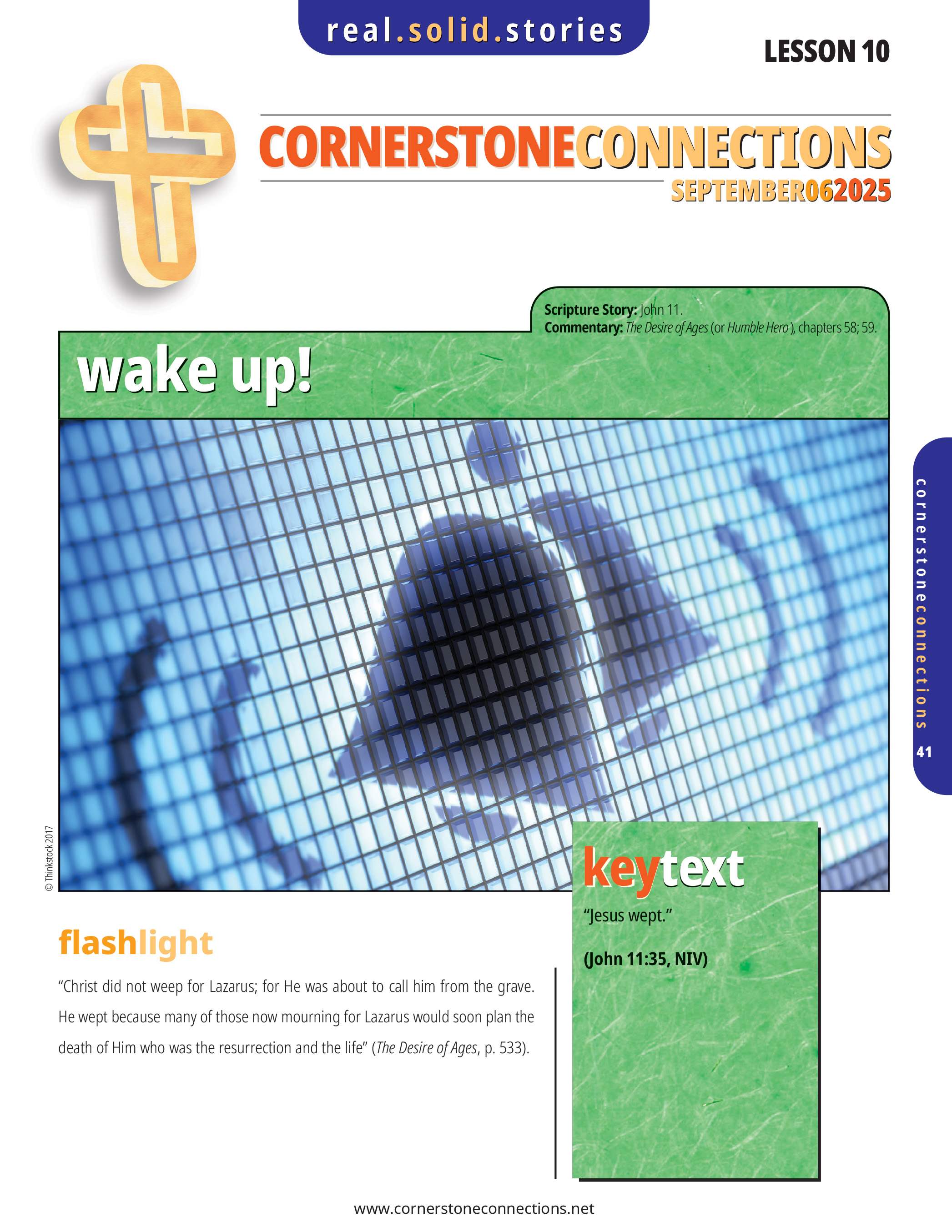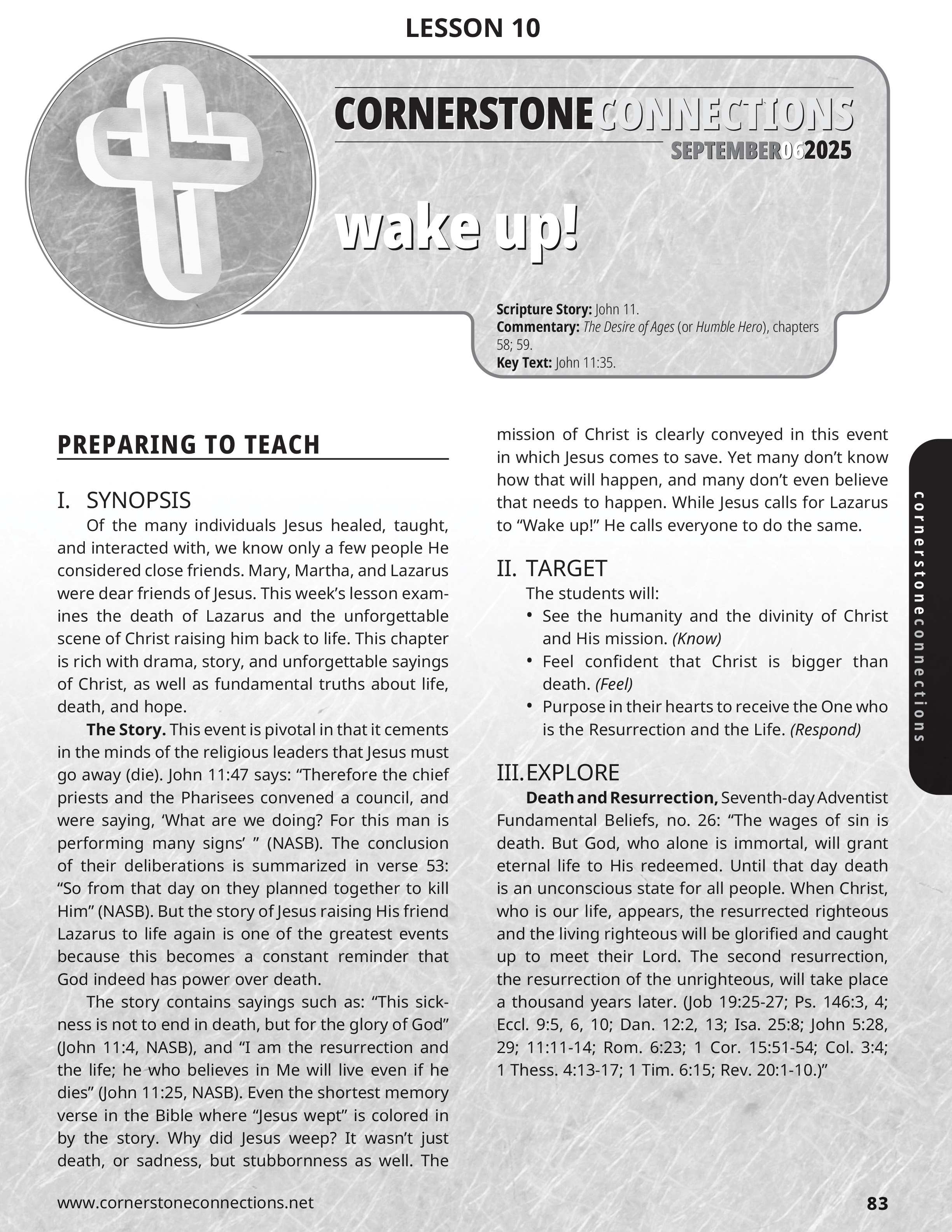Wake Up!
Click below to download the Cornerstone Connections leader’s guide and student lesson. This week’s resources also include two lesson plans and a discussion starter video which offer different ways of looking at the topic. Each lesson plan includes opening activities, scripture passages, discussion questions, and real-life applications.
As Jesus was standing at the graveside of His friend Lazarus, Scripture tells us that He wept. Why? Was He sad? Did He miss His friend? Or was it more than that?
Humble Hero (Desire of Ages)
Chapter 58 - The Raising of Lazarus

Humble Hero (Desire of Ages)
Chapter 59 - Continued Plotting

This lesson shows that even though we know God will eventually make everything better, it’s still OK to be sad.
Divide your students into two groups. Ask one group to come up with a worst case scenario for the first situation you present them with. The other group will come up with a best case scenario for the same situation. Have the groups switch with each incident you present, whether they are doing the best case or the worst case scenario. Each “worst” and “best” should be original and not merely mimic a previous one presented.
Do you have a Bible verse memorized? (Ask students to share a verse/passage they have memorized in the past. Encourage them, perhaps providing a prize for students who can recite a Bible passage from memory.)
Scripture memorization is an ancient and important spiritual discipline. (This is my story; you can share one of you own.) I remember trying to play games like football or baseball on Sabbath afternoon. In my family those were not approved Sabbath activities, so one of the things I did was try to incorporate scripture into the game. For example, each base or first down you made you had to say a Bible verse. My parents didn’t really approve, but my favorite verse for this game was found in the passage we are studying today – John 11:35. It’s the shortest verse in the Bible. It simply says, “Jesus wept.” We are going to look at the story around this verse and talk about what happens when sad things happen today.
Probably one of the more recognizable stories about Jesus is our story today. It is a story of hope, family, friendship, and love. It is also in many ways one of the more relatable stories in scripture because it deals with the human experience of loss and death. Over the course of the pandemic maybe you have experienced loss.
(Give the group some time to share.)
The passage today is about loss. We will look at how three different groups dealt with loss: the disciples, Lazarus’ family and friends, and Jesus. As we open our Bibles, the story of Lazarus begins with Jesus and the disciples hearing that their friend Lazarus is ill. We also learn that Jesus seems to be very well acquainted with Lazarus’ sisters, Mary and Martha. However, Jesus delays and doesn’t head straight to heal Lazarus. Jesus somehow divinely knows that Lazarus has died of his illness.
Read John 11:11-16.
11 After saying these things, he said to them, “Our friend Lazarus has fallen asleep, but I go to awaken him.” 12 The disciples said to him, “Lord, if he has fallen asleep, he will recover.” 13 Now Jesus had spoken of his death, but they thought that he meant taking rest in sleep. 14 Then Jesus told them plainly, “Lazarus has died, 15 and for your sake I am glad that I was not there, so that you may believe. But let us go to him.” 16 So Thomas, called the Twin, said to his fellow disciples, “Let us also go, that we may die with him.”
This text is often used to talk about the belief that death is like sleep. We would be remiss if we didn’t talk about that here.
Read John 11:20-32.
20 So when Martha heard that Jesus was coming, she went and met him, but Mary remained seated in the house. 21 Martha said to Jesus, “Lord, if you had been here, my brother would not have died. 22 But even now I know that whatever you ask from God, God will give you.” 23 Jesus said to her, “Your brother will rise again.” 24 Martha said to him, “I know that he will rise again in the resurrection on the last day.” 25 Jesus said to her, “I am the resurrection and the life. Whoever believes in me, though he die, yet shall he live, 26 and everyone who lives and believes in me shall never die. Do you believe this?” 27 She said to him, “Yes, Lord; I believe that you are the Christ, the Son of God, who is coming into the world.”
28 When she had said this, she went and called her sister Mary, saying in private, “The Teacher is here and is calling for you.” 29 And when she heard it, she rose quickly and went to him. 30 Now Jesus had not yet come into the village, but was still in the place where Martha had met him. 31 When the Jews who were with her in the house, consoling her, saw Mary rise quickly and go out, they followed her, supposing that she was going to the tomb to weep there. 32 Now when Mary came to where Jesus was and saw him, she fell at his feet, saying to him, “Lord, if you had been here, my brother would not have died.”
Read John 11:33-35.
33 When Jesus saw her weeping, and the Jews who had come with her also weeping, he was deeply moved in his spirit and greatly troubled. 34 And he said, “Where have you laid him?” They said to him, “Lord, come and see.” 35 Jesus wept.

LEADER’S NOTE
For a Relational Bible Study (RBS) you’ll want to get into the Scripture passage and encourage the youth to imagine participating in the story while it’s happening. Then you will be able to better apply it to your own situation today.
You will need to ask God for the Holy Spirit to be present as your small group discusses the questions (no more than 3-6 people in a group is recommended). Start with the opening question. It is a personal question and the answer is unique for each individual. There is no right answer and nobody is an expert here, so don’t be surprised when you hear different responses. You are depending on the Holy Spirit to be present and to speak through your group. Say what God prompts you to say, and listen to what others share.
Take turns reading the chapter out loud. Follow that with giving the students some time to individually mark their responses to the questions (a PDF version of the handout is available as a download). This gives each person a starting point for responding when you start to share as a group. Next, begin the discussion by asking the students to share what they marked and why on each question as you work your way through. Feel free to take more time on some questions than others as discussion warrants.
Encourage each person in the group to apply what is discussed to their personal lives and to share with the group what they believe God wants them to do. Then ask them to pray that God will help each of them to follow through in doing so. Remind them to expect that God will show them ways to live out the message of this passage in the coming week, and that they are free to ask others in the group to help hold them accountable.
Although many in your Youth Sabbath School might be familiar with the story of Jesus resurrecting Lazarus, setting the stage might take them into a deeper experience with the story in John 11. Note these elements that some overlook when just recounting the basic story.
One way to make the story more personal would be for participants to take the role of someone in the story, such as Mary or Martha, one of the disciples, a professional mourner, a skeptical observer who reports to the Pharisees in Jerusalem, or Lazarus himself. Let them choose the character they want to be, or assign a character to each person. Invite them to read or listen to the story from that perspective and then share their unique perspective with the rest of the group.
What is your earliest memory about the reality that people on earth die?
Read John 11:1-57.
1 Now a man named Lazarus was sick. He was from Bethany, the village of Mary and her sister Martha. 2 (This Mary, whose brother Lazarus now lay sick, was the same one who poured perfume on the Lord and wiped his feet with her hair.) 3 So the sisters sent word to Jesus, “Lord, the one you love is sick.”
4 When he heard this, Jesus said, “This sickness will not end in death. No, it is for God’s glory so that God’s Son may be glorified through it.” 5 Now Jesus loved Martha and her sister and Lazarus. 6 So when he heard that Lazarus was sick, he stayed where he was two more days, 7 and then he said to his disciples, “Let us go back to Judea.”
8 “But Rabbi,” they said, “a short while ago the Jews there tried to stone you, and yet you are going back?”
9 Jesus answered, “Are there not twelve hours of daylight? Anyone who walks in the daytime will not stumble, for they see by this world’s light. 10 It is when a person walks at night that they stumble, for they have no light.”
11 After he had said this, he went on to tell them, “Our friend Lazarus has fallen asleep; but I am going there to wake him up.”
12 His disciples replied, “Lord, if he sleeps, he will get better.” 13 Jesus had been speaking of his death, but his disciples thought he meant natural sleep.
14 So then he told them plainly, “Lazarus is dead, 15 and for your sake I am glad I was not there, so that you may believe. But let us go to him.”
16 Then Thomas (also known as Didymus) said to the rest of the disciples, “Let us also go, that we may die with him.”
17 On his arrival, Jesus found that Lazarus had already been in the tomb for four days. 18 Now Bethany was less than two miles from Jerusalem, 19 and many Jews had come to Martha and Mary to comfort them in the loss of their brother. 20 When Martha heard that Jesus was coming, she went out to meet him, but Mary stayed at home.
21 “Lord,” Martha said to Jesus, “if you had been here, my brother would not have died. 22 But I know that even now God will give you whatever you ask.”
23 Jesus said to her, “Your brother will rise again.”
24 Martha answered, “I know he will rise again in the resurrection at the last day.”
25 Jesus said to her, “I am the resurrection and the life. The one who believes in me will live, even though they die; 26 and whoever lives by believing in me will never die. Do you believe this?”
27 “Yes, Lord,” she replied, “I believe that you are the Messiah, the Son of God, who is to come into the world.”
28 After she had said this, she went back and called her sister Mary aside. “The Teacher is here,” she said, “and is asking for you.” 29 When Mary heard this, she got up quickly and went to him. 30 Now Jesus had not yet entered the village, but was still at the place where Martha had met him. 31 When the Jews who had been with Mary in the house, comforting her, noticed how quickly she got up and went out, they followed her, supposing she was going to the tomb to mourn there.
32 When Mary reached the place where Jesus was and saw him, she fell at his feet and said, “Lord, if you had been here, my brother would not have died.”
33 When Jesus saw her weeping, and the Jews who had come along with her also weeping, he was deeply moved in spirit and troubled. 34 “Where have you laid him?” he asked.
“Come and see, Lord,” they replied.
35 Jesus wept.
36 Then the Jews said, “See how he loved him!
37 But some of them said, “Could not he who opened the eyes of the blind man have kept this man from dying?”
38 Jesus, once more deeply moved, came to the tomb. It was a cave with a stone laid across the entrance. 39 “Take away the stone,” he said.
“But, Lord,” said Martha, the sister of the dead man, “by this time there is a bad odor, for he has been there four days.”
40 Then Jesus said, “Did I not tell you that if you believe, you will see the glory of God?”
41 So they took away the stone. Then Jesus looked up and said, “Father, I thank you that you have heard me. 42 I knew that you always hear me, but I said this for the benefit of the people standing here, that they may believe that you sent me.”
43 When he had said this, Jesus called in a loud voice, “Lazarus, come out!” 44 The dead man came out, his hands and feet wrapped with strips of linen, and a cloth around his face.
Jesus said to them, “Take off the grave clothes and let him go.”
45 Therefore many of the Jews who had come to visit Mary, and had seen what Jesus did, believed in him. 46 But some of them went to the Pharisees and told them what Jesus had done. 47 Then the chief priests and the Pharisees called a meeting of the Sanhedrin.
“What are we accomplishing?” they asked. “Here is this man performing many signs. 48 If we let him go on like this, everyone will believe in him, and then the Romans will come and take away both our temple and our nation.”
49 Then one of them, named Caiaphas, who was high priest that year, spoke up, “You know nothing at all! 50 You do not realize that it is better for you that one man die for the people than that the whole nation perish.”
51 He did not say this on his own, but as high priest that year he prophesied that Jesus would die for the Jewish nation, 52 and not only for that nation but also for the scattered children of God, to bring them together and make them one. 53 So from that day on they plotted to take his life.
54 Therefore Jesus no longer moved about publicly among the people of Judea. Instead he withdrew to a region near the wilderness, to a village called Ephraim, where he stayed with his disciples.
55 When it was almost time for the Jewish Passover, many went up from the country to Jerusalem for their ceremonial cleansing before the Passover. 56 They kept looking for Jesus, and as they stood in the temple courts they asked one another, “What do you think? Isn’t he coming to the festival at all?” 57 But the chief priests and the Pharisees had given orders that anyone who found out where Jesus was should report it so that they might arrest him.
1. Why did Jesus delay two days before going to Lazarus?
2. Why did the disciples object to returning to Judea?
3. What does this chapter tell you about the resurrection of the dead?
4. What’s the significance of Lazarus’ resurrection happening in Bethany?
5. Why did Jesus weep?
6. How did the religious leaders respond to the resurrection of Lazarus?
7. What is the likelihood you will someday experience death as “sleep”? What about experiencing death as “death”? What’s the difference?
8. How much “life” do you have? Do you have “eternal life”? How would you know?
Miracles create quite a bit of excitement. But resurrection might be the most spectacular miracle. That just doesn’t happen! By this public act next door to Jerusalem, people had to either embrace Jesus as God or eliminate Him. As preposterous as it sounds, the religious leaders decided to kill Jesus/God—as if they could do that, and as if Jesus couldn’t be resurrected from the dead. The resurrection of Lazarus forced things to a breaking point. And the resurrection of Jesus shortly after this has changed the history of this world and of our individual lives.
When this story goes beyond a wonderful tale for children, it can have major ramifications for how we live. For example, if Jesus is (present tense) resurrection and life, then those who have Jesus can’t die even though they might “sleep.” What human being on earth can escape death? If you have Jesus, does that make it impossible for you to actually die (the second death)?
How will you relate to death, and to life, because of Christ’s claim that He IS the resurrection and life? Here are a few ideas the youth in your Sabbath School class could put into practice this week.
Every human being dies, right? For many young people, that seems like something that just happens to “old people”—like those who are over the age of 30. But young people, even teens and children, sometimes die “early.” If that has happened recently to someone in your youth group, the pain is probably still quite fresh. Sometimes it’s actually good to address death when it’s not overwhelming us. In this way, we can have a foundation for when it does knock us off our feet.
Jesus blew everyone away when He resurrected Lazarus. Shortly after that, Jesus blew everyone away even more when He was resurrected from the dead. Those resurrections provided a foretaste of the reality of the final resurrection Martha referenced in her conversation with Jesus (John 11:23-24). But Jesus moved that from the future tense to the present tense: “I AM the resurrection and the life” (John 11:25).
Because we get bombarded by death each day on this planet, and not just during a pandemic, it seems like death remains inevitable for everyone. None of us chose to be born into this world, but here we are. We do have a choice if we will move beyond “existence” and really “live.”




